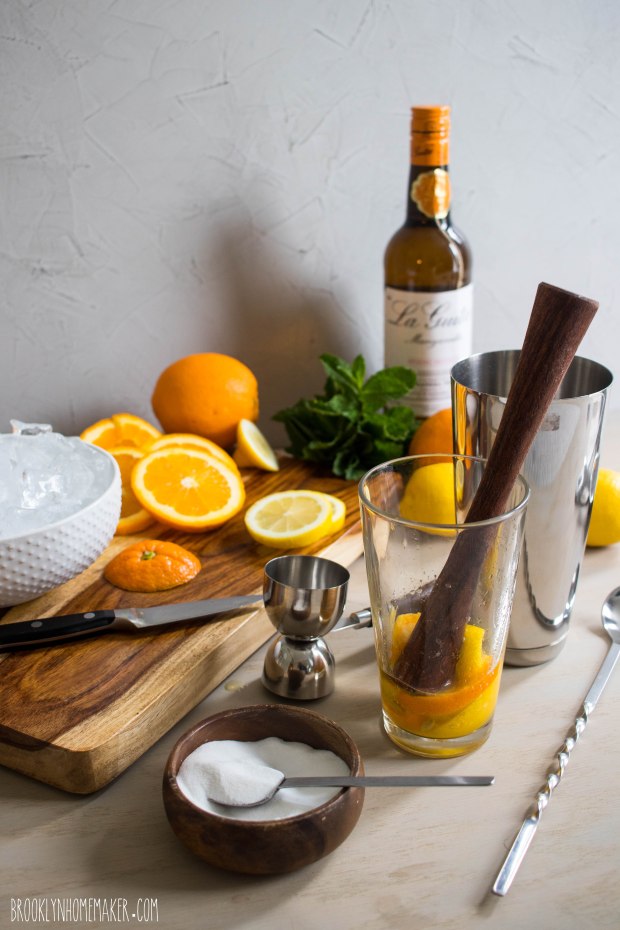The Sherry cobbler is a historic recipe, and when I say historic, I mean it!
I’m all too well aware that fancy speakeasies and prohibition era cocktail lounges are all the rage right now, but this drink pre-dates even those. While those cocktails were popular in the 1920s or 30s, the Sherry Cobbler most likely came of age sometime in the 1820 or 30s and really took off in the 1840s!
They say that like champagne was to the 1920s, or the Cosmo to the 1990s, The Sherry Cobbler was a quintessential part of American life and culture in the 1800s. In fact, when Charles Dickens visited the US, it was one of his favorite things about his trip and he talks about it in his 1844 book The Life and Adventures of Martin Chuzzlewit. “Martin took the glass with an astonished look; applied his lips to the reed; and cast up his eyes once in ecstasy. He paused no more until the goblet was drained to the last drop. ‘This wonderful invention, sir,’ said Mark, tenderly patting the empty glass, ‘is called a cobbler. Sherry Cobbler when you name it long; cobbler, when you name it short.’”
The “reed” mentioned in this passage refers to what we today call a straw. At the time this was written, a drinking straw was a total novelty, and people in bars would often need to be shown how to use one because it was so unfamiliar. The Sherry Cobbler is actually credited with introducing the straw to popular consciousness in America! These weren’t the demonized plastic straws of today though, but a rye or reed straw, a bi-product of the hay industry. Today similar straws are making a comeback as America tries to find alternatives to plastic straws, and in fact the straws you see pictured here are the very same!
I got them from a company called HAY! straws.
So- what is a Sherry Cobbler?
I’m glad you asked.
It’s essentially Sherry, shaken with muddled citrus & sugar, and strained and poured over crushed ice. It also happens to be super delicious and refreshing, especially on a hot day. It’s sweet and bright and citrusy in all the best possible ways, and not too boozy, so you can keep ’em comin’!
A few things made the popularity of the Sherry Cobbler possible at this specific time in American history.
Sherry, a fortified wine from Andalusia Spain, had recently started to find it’s way into America as trade increased and tariffs dropped. Nineteenth-century Americans saw sherry as foreign, fancy, and affordable all at once, and it became very popular.
Sugar and citrus were also making their way into American homes as trade increased and prices dropped. Suddenly even in Northern states, people were able to get fresh citrus at certain times of year when it had been extremely rare before. Cheap sugar meant that Americans developed a real sweet tooth though, so I actually scaled back the sugar in my recipe, because I found the original recipe a bit too sweet for modern tastes.
Perhaps the most important part of the drink though, was the ice! Before this point, most alcoholic beverages were served warm or hot, because ice was rare and expensive and refrigeration wasn’t yet a thing. At that point, ice had to be harvested by sawing huge blocks out of frozen lakes and storing them in ice houses. In the 1840s though, they began to industrialize the harvesting process, and suddenly ice was affordable and readily available, so it could be used on frivolous things like drinks. To me, the crushed ice in this drink makes it feel a bit like an adult snow-cone! It also means that if you tipped the glass toward your mouth, the ice would spill all over you, hence what I said before about this cocktails singlehandedly popularizing the drinking straw!
I used a canvass ice crushing bag called a Lewis Bag, along with a mallet (I used my CLEAN meat tenderizer) to get my finely crushed snowy ice!
I know this is a very summery cocktail to be sharing in October, but there’s a very good reason that I’ve waited until now to share it with you.
Over the past few months, I’ve been working on a special project with my good friend Stephanie…
We’re starting a podcast!!!
I hope this doesn’t break your hearts baking lovers, but food is not the theme of our show. There will be a cocktail featured in each episode though, if that softens the blow at all.
You already know I love history, but I also really love politics. Now, as a food blogger, discussing politics has always been a touchy subject because it’s such a personal thing and I don’t want to alienate anyone who just came here to look at bundt cakes. I’ve touched on a few specific topics over the years, when the issues at hand were incredibly important to me, but for the most part, I’ve left that part of my life out of Brooklyn Homemaker.
Don’t worry though, Stephanie and I will NOT be discussing current events on our show. There are plenty of voices out there already doing that. Our podcast will actually be about the politics of the past, specifically political scandals from American History! The show is called Beyond Reproach, because while we believe public servants should be squeaky clean upstanding citizens, history has shown us time and time again that they definitely ain’t. I know this topic may sound dull, but I promise it’s presented in a really fun way. Basically, we’ll be telling each other stories from America’s sordid past as we drink fancy cocktails, talk too much, interrupt each other, put our feet in our mouths, and go off on (sometimes totally unrelated) tangents. If cursing offends you, this probably isn’t the show for you, but I promise it’s hilarious, eye-opening, and educational all at once!
What does all this have to do with this old-timey cocktail recipe you ask?
Well, for each episode we choose a cocktail that was popular during the era of the first scandal we discuss. In our very first episode, Stephanie tells a story from the late 1800s, so this was the first cocktail we featured.
Not only that, but today also just happens to be the very day that we officially launched the show, and to celebrate I wanted to share my fun new project with all of you! Nothing would make me happier than to have you come over and check us out!
I won’t overwhelm you with all the social media and all that, but please click these links to find us on itunes, and check out our show’s website.
Please do check us out, and if you like us, don’t forget to subscribe to the show, and maybe even give us a rating or review on your favorite pod catcher!!!
Thanks y’all! I hope to see you over at Beyond Reproach!
The Sherry Cobbler
2 orange wheels (1 for garnish)
2 lemon wheels (1 for garnish)
2 teaspoons superfine sugar, (or 1/2 oz simple syrup)
3 ounces dry Sherry (amontillado or mazanilla)
mint sprig and raspberries for garnish
Muddle 1 orange wheel, 1 lemon wheel, and sugar or simple syrup together in a cocktail shaker. Add Sherry and plenty of ice, and shake vigorously until outside is frosty, about 30 seconds.
Strain into a collins or highball glass filled to the top with crushed ice. Add more crushed ice, packing into the glass and mounding above rim. Garnish with mint, raspberry, an orange wheel, and a lemon wheel. Drink with a straw, and enjoy!



































